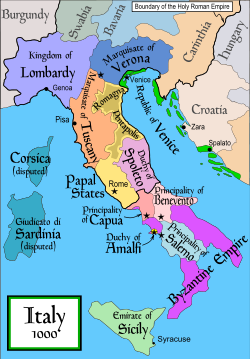- March of Tuscany
-
March of Tuscany
Marca di TusciaState of the Holy Roman Empire ← 
846–1115  →
→
 →
→
 →
→
 →
→The March of Tuscany in the political context of Italy around AD 1000 Capital Lucca Government Principality Historical era Early Middle Ages - Frankish invasion of
Lombard kgdm
774- Adalbert I granted
margraviate
846- Granted to Boso 931 - Rainier deposed in
favour of Hse Canossa
1027- Ducal line extinct on
Matilda's death
1115Today part of  Italy
ItalyThe March (or margraviate) of Tuscany or Tuscia was a frontier march in central Italy, bordering the Papal States to the south and east, the Ligurian Sea to the west, and the rest of the Kingdom of Italy to the north. It was a Carolingian creation, a successor of the Lombard Duchy of Tuscia. The march itself comprised a collection of counties, largely in the valley of the Arno, centred around the County of Lucca, which was sometimes called a duchy.
The first Tuscan margrave was Adalbert I, who was granted that title in 846. Before him, his father and grandfather, Boniface I and Boniface II, had controlled most of the counties of the region and had held higher titles as well, such as prefect of Corsica or duke of Lucca. The Bonifacii held the march until 931. During the late ninth and early tenth century, the support of the margraves of Tuscany was instrumental for any candidate intent on becoming King of Italy.
In 931, Hugh of Arles, who had made himself King of Italy, dispossessed the Bonifacii in an attempt to consolidate all the important fiefs of Italy in his relatives' hands. He granted Tuscany to his brother Boso. It remained in the hands of members of the family known as the Bosonids down to 1001. It also retained its influence regarding royal elections. As late as 1027, Rainier was deposed from the march by Conrad II for opposing him as king.
In 1027, the duchy was granted to the counts of Canossa. Boniface III used the title dux et marchio: duke and margrave. He was an ally of the Holy Roman Emperors, but his power was so great that he threatened that of the emperors in Italy. He united the Canossa inheritance, which was largely in the Emilia, to Tuscany and passed it on to his daughter Matilda. Beside her vast Emilian allods, Tuscany, held in feudal tenure, was her greatest possession and she wielded it to the benefit of the Papacy in the Investiture Controversy. After Matilda's death in 1115, no further margraves were appointed and the era of the feudal princes had passed in northern Italy, to be replaced by the dominance of the city-states, maritime republics and communes.
See also
- List of rulers of Tuscany
- Republic of Florence
- Italian city-states
Sources
- Wickham, Chris. Early Medieval Italy: Central Power and Local Society 400–1000. MacMillan Press: 1981.
Categories:- Former principalities
- Former countries on the Italian Peninsula
- States of the Holy Roman Empire
- States and territories established in 846
- Medieval Italy
Wikimedia Foundation. 2010.

